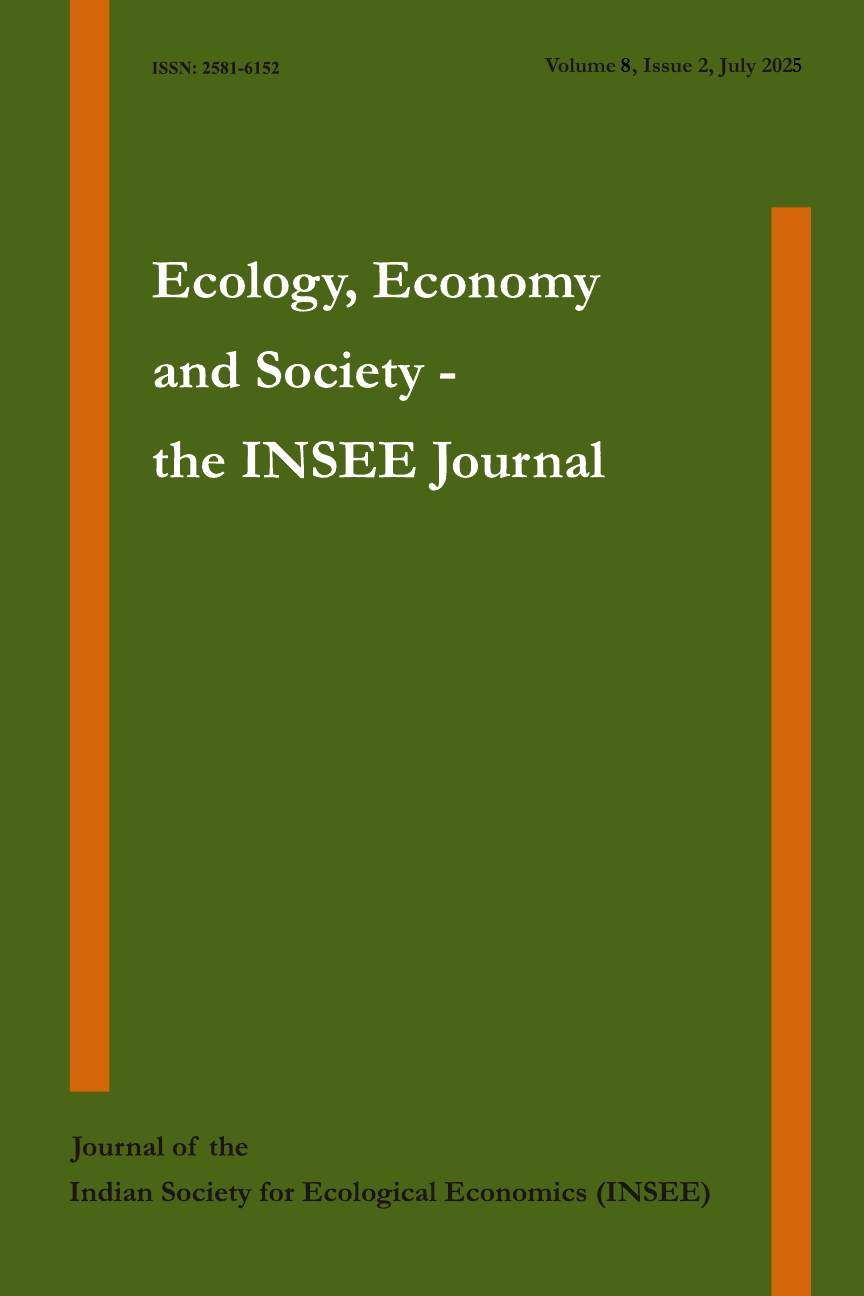Every Drop Counts
Gendered Impacts of Solar Pumps, Within and Outside Rural Households in Chhattisgarh
DOI:
https://doi.org/10.37773/ees.v8i8.1671Downloads
References
Bassi, Nitin. 2017. “Solarizing Groundwater Irrigation in India: A Growing Debate.” International Journal of Water Resources Development 34 (1): 132–45. https://doi.org/10.1080/07900627.2017.1329137.
Buisson, Marie-Charlotte, Archisman Mitra, Thierry Hounsa, Md Ahasan Habib, and Aditi Mukherji. 2024. “A Place in the Sun: Farmers’ Co-Benefits from Solar Irrigation in Bangladesh.” Energy Economics 140 (107973). https://doi.org/10.1016/j.eneco.2024.107973.
Burney, Jennifer, Lennart Woltering, Marshall Burke, Rosamond Naylor, and Dov Pasternak. 2010. “Solar-Powered Drip Irrigation Enhances Food Security in the Sudano-Sahel.” Proceedings of the National Academy of Sciences 107 (5): 1848–53. https://doi.org/10.1073/pnas.0909678107.
Chhattisgarh State Renewable Energy Development Agency. n.d. “Saur Sujala Yojna.” Department of Energy, Chhattisgarh Government. Accessed March 21, 2025. https://www.creda.co.in.
ICA–IIEC. 2022. Evaluation and Impact Assessment of Solar Irrigation Pumps. International Copper Association–International Institute for Energy Conservation. https://asi.copperindia.org/wp-content/uploads/2022/12/ICA-IIEC-White-Paper_Solar-Irrigation-Pumps_01-July-2022.pdf.
Kabeer, Naila. 1999. “Resources, Agency, Achievements: Reflections on the Measurement of Women’s Empowerment.” Development and Change 30 (3): 435–64. doi:10.1111/1467-7660.00125.
Meinzen-Dick, Ruth S., Deborah Rubin, Marlène Elias, Annet Abenakyo Mulema, and Emily Myers. 2019. “Women’s Empowerment in Agriculture: Lessons from Qualitative Research.” IFPRI Discussion Paper 1797. https://papers.ssrn.com/sol3/Delivery.cfm/SSRN_ID3330214_code1123746.pdf?abstractid=3330214&mirid=1.
MoSPI. 2025. Energy Statistics India 2025. Ministry of Statistics and Programme Implementation, Government of India. https://mospi.gov.in/sites/default/files/publication_reports/Energy_Statistics_2025/Energy%20Statistics%20India%202025_27032025.pdf.
Rahman, Anas, and Abhishek Jain. 2022. “Community-Based Solar Irrigation in Chhattisgarh: Prospects and Challenges.” Council on Energy, Environment and Water. https://www.ceew.in/sites/default/files/ceew-study-on-impact-of-solar-pumps-powered-irrigation-in-chhattisgarh.pdf.
Shah, Tushaar. 2009. “Climate Change and Groundwater: India’s Opportunities for Mitigation and Adaptation.” Environmental Research Letters 4 (3): 035005. https://doi.org/10.1088/1748-9326/4/3/035005
Suman, Shikha. 2018. “Evaluation and Impact Assessment of the Solar Irrigation Pumps Program in Andhra Pradesh and Chhattisgarh.” Shri Shakti Alternative Energy Limited. https://www.ssael.co.in/images/Library/files/Solar-Pumps-Impact--SSAEL-Report.pdf.
Sunny, Faruque As, Mohammad Ariful Islam, Taonarufaro Tinaye Pemberai Karimanzira, Juping Lan, Md Sadique Rahman, and Huang Zuhui. 2023. “Adoption Impact of Solar Based Irrigation Facility by Water-Scarce Northwestern Areas Farmers in Bangladesh: Evidence from Panel Data Analysis.” Frontiers in Energy Research 10 (January). https://doi.org/10.3389/fenrg.2022.1101404
White, Howard. 2009. “Theory-Based Impact Evaluation: Principles and Practice.” Journal of Development Effectiveness 1 (3): 271–84. doi:10.1080/19439340903114628.
Additional Files
Published
How to Cite
Issue
Section
License
Copyright (c) 2025 Mugdha Khandelwal

This work is licensed under a Creative Commons Attribution-NonCommercial 4.0 International License.
Copyright
The author(s) retain copyright on work published by INSEE unless specified otherwise.
Licensing and publishing rights
Author(s) of work published by INSEE are required to transfer non-exclusive publishing right to INSEE of the definitive work in any format, language and medium, for any lawful purpose.
Authors who publish in Ecology, Economy and Society will release their articles under the Creative Commons Attribution NonCommercial 4.0 International (CC BY-NC 4.0) license. This license allows anyone to copy and distribute the article for non-commercial purposes provided that appropriate attribution is given.
For details of the rights that the authors grant users of their work, see the "human-readable summary" of the license, with a link to the full license. (Note that "you" refers to a user, not an author, in the summary.)
The authors retain the non-exclusive right to do anything they wish with the published article(s), provided attribution is given to the Ecology, Economy and Society—the INSEE Journal with details of the original publication, as set out in the official citation of the article published in the journal. The retained right specifically includes the right to post the article on the authors’ or their institution’s websites or in institutional repositories.
In case of re-publishing a previously published work, author may note that earlier publication may have taken place a license different from Creative Commons. In all such cases of re-publishing, we advise the authors to consult the applicable licence at article level.








 Ecology, Ecoomy and Society--the INSEE Journal is a society run diamond Open Access and Scopus indexed journal.
Ecology, Ecoomy and Society--the INSEE Journal is a society run diamond Open Access and Scopus indexed journal.